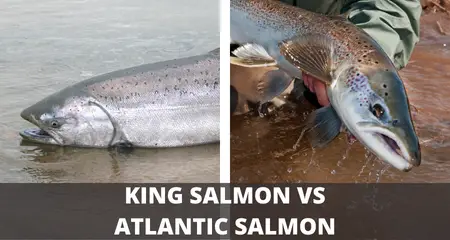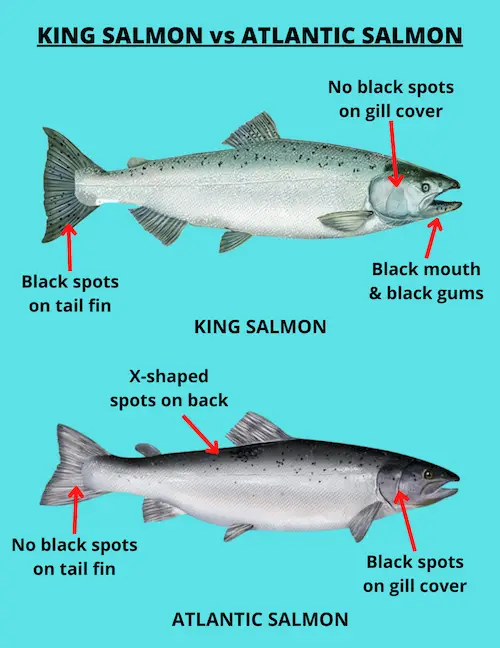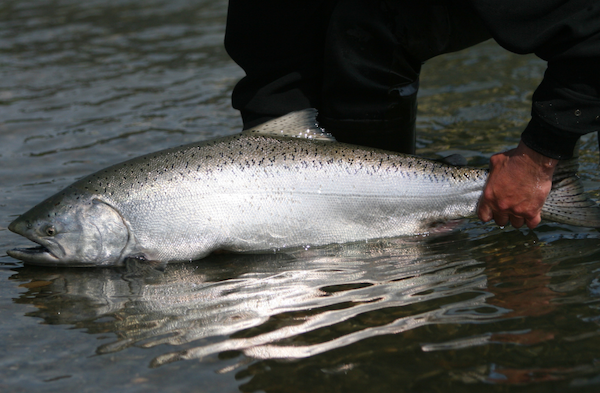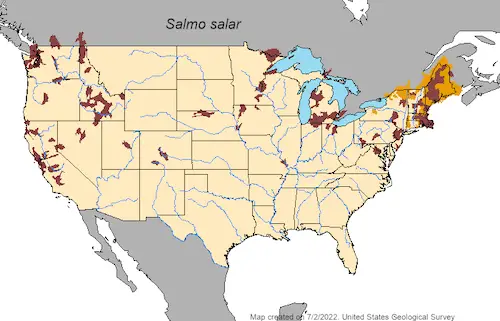King Salmon Vs Atlantic Salmon (How Are They Different?)
UPDATED 03 NOVEMBER 2023
by Robert Ceran
King salmon and Atlantic salmon are two of the most popular salmon species in the world, both as game fish and as table fare.
But it’s important to be able to tell the difference between Atlantic and king salmon, since they have different bag limits in fisheries where they occur together.
Also, there is a clear difference in the quality of their taste, and this is important to be aware of before you decide which salmon species you want to cook for dinner.

In this article we’ll explain the key differences between king salmon and Atlantic salmon, to help you tell them apart easily on your next fishing trip, and we’ll also cover which one of them tastes better.
What is the difference between King salmon and Atlantic salmon?
The main difference between king (chinook) salmon and Atlantic salmon is that king salmon are bigger on average, and are native to the Pacific seaboard of North America and Asia, while the Atlantic salmon is native to the Atlantic seaboard of North America and Europe.
However, both salmon species have been introduced into waters outside of their original range over the past decades, and as a result of this sometimes occur in the same waters.
As a result, even though Atlantic and king salmon have different geographic origins, they now co-occur in some bodies of water, including the Great Lakes and other water bodies in North America (more on that below).
Finally, in terms of taste, king salmon is generally considered to have a superior flavor to Atlantic salmon, though this could be due to the fact that most Atlantic salmon is farmed, while king salmon is generally wild caught.
King salmon vs Atlantic salmon – identification guide
Now let’s cover the key features that distinguish king salmon from Atlantic salmon.
Overall, Atlantic salmon tend to have a more slender and torpedo shaped body, while king salmon tend to have a more stocky build.

The image above summarizes the key differences between king salmon vs Atlantic salmon. You can use these features to reliably distinguish the two salmon species from each other.
Let’s take a closer look at each of these.
Tail fin: While king salmon have small dark spots scattered over their tail fin, Atlantic salmon have no spots on their tail.
In addition, king salmon also tend to have a wider base of their tail fin, while Atlantic salmon have a more slender base of their tail fin. But keep in mind that this difference is not reliable enough to be used for conclusive identification on its own.
Body spots: While king salmon usually have round or oval black spots on their back, Atlantic salmon have x-shaped or y-shaped spots on their back.
Mouth color: While king salmon have a black mouth with black gums (explaining why they’re also called blackmouth salmon), Atlantic salmon have a grayish white mouth and gums.
Mouth size: While the rear edge of the mouth of a king salmon generally extends further back than its eye, the rear edge of an Atlantic salmon’s mouth doesn’t extend past its eye.
However, this difference is not absolute, and can’t be used on its own to conclusively distinguish the two types of salmon from each other.
Gill cover: While Atlantic salmon have black spots on their gill cover, king salmon have no spots on their gill cover.
How to catch king salmon vs Atlantic salmon
The fishing tactics and baits used to catch king salmon and Atlantic salmon are very similar, and vary depending on where you want to catch them.
When fishing in the open waters of lakes and ocean bays, the most effective method is salmon trolling.
Since salmon like to hold in deep water over 100 feet, it may be necessary to use downriggers to get your trolling lures far enough down in the water column.
However, when Atlantic or king salmon migrate into rivers, the fishing tactics for catching them change completely. Now you either use a fly fishing setup, or a salmon fishing rig set up designed for fishing in rivers and streams.
King salmon (key facts)

Scientific name: Oncorhynchus tshawytscha
The king salmon (also known as chinook salmon) is the largest salmon species in the world, reaching more than 100 pounds in weight.
The largest king salmon caught by commercial fishermen weighed 126 pounds, while the largest king salmon caught by recreational anglers weighed 97 pounds.
King salmon are one of the most sought after game fish in the world, with anglers traveling thousands of miles to catch them in Alaska and Canada during the peak season.
However, since king salmon have been successfully introduced into many lakes, including the Great Lakes, you can find excellent king salmon fishing spots in New York, Michigan, and other salmon fishing spots in the USA where they did not exist before.
Where can you find King salmon?
King salmon are originally native to the Pacific seaboard of North America and northern Asia, with its North American range extending from Monterey, California in the south, to northern Alaska in the north.
Anglers of the Pacific Northwest developed a very effective fishing technique that involves using a mooching rig for king salmon.
King salmon have been successfully introduced into many other parts of the country, including the Great Lakes region and other lakes across the USA.
Finally, king salmon are also farmed in Chile and New Zealand, where they can also be caught in the wild in some areas.
Atlantic salmon (key facts)

Scientific name: Salmo salar
The Atlantic salmon is the only salmon species native to the Atlantic ocean. It is slightly smaller than the king salmon, but can also reach huge sizes north of 100 pounds. The largest Atlantic salmon ever recorded weighed 105 pounds.
In addition to being a prized game fish on the bucket list of most anglers, Atlantic salmon also make up the majority of salmon that are farmed in Norway, Scotland, Canada, and Chile.
These salmon are exported to hundreds of countries around the world, and constitute one of the most popular eating fish.
Where can you find Atlantic salmon?
Atlantic salmon were originally found along the northeastern seaboard of the USA and Canada, but native populations of Atlantic salmon are now largely extinct in these areas (though small breeding populations still remain in Maine and Quebec).
However, while native Atlantic salmon are largely extinct in North America, they have been successfully reintroduced and stocked in many areas, including rivers and lakes in both the western and eastern USA.
Can King salmon and Atlantic salmon be in the same body of water?
Yes, due to salmon stocking and salmon farming, king salmon and Atlantic salmon can now be found together in the same water body in a range of fisheries.
The most prominent location where Atlantic and king salmon co-occur is in the Great Lakes region of North America.
King salmon were originally introduced into Lake Michigan in order to control the alewife population, but following the success of this stocking effort, king salmon were stocked in all of the Great Lakes.
And, since Atlantic salmon are also stocked in the same fisheries, both fish are regularly encountered side by side, and anglers are able to catch both types of salmon on the same fishing trip.
For example, if you’re trolling for salmon in the Great Lakes, there’s a good chance of catching both king and Atlantic salmon on the same trip.
In addition to this, some Atlantic salmon regularly escape from salmon farms in Canada and Alaska, and as a result Atlantic and king salmon can be found in the same waters of the Pacific seaboard.
King salmon vs Atlantic salmon taste
King salmon has the highest fat content of all salmon species, but does it taste better or worse than Atlantic salmon?
While taste is a fairly subjective thing, there seems to be a broad consensus about which of these two salmon species taste better.
Which tastes better: King or Atlantic salmon?
Most salmon lovers agree that King salmon tastes better than Atlantic salmon. This could be due to the fact that it has higher fat content, stronger flavor and thicker meat.
But another thing to keep in mind is that most King salmon sold in North America is wild caught, while most Atlantic salmon is farmed.
And if you’ve ever compared wild caught trout with farmed trout you’ll know that farmed fish are nowhere near as tasty as their wild counterparts.
So if you’re wondering whether to cook king salmon or Atlantic salmon for dinner, king salmon is probably the better choice, though both salmon species make excellent table fare.


